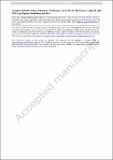Accurate Effective Stress Measures: Predicting Creep Life for 3D Stresses Using 2D and 1D Creep Rupture Simulations and Data
Author(s)
Rovinelli, Andrea; Messner, Mark C.; Parks, David M.; Sham, Ting-Leung
Download40192_2021_228_ReferencePDF.pdf (1002.Kb)
Open Access Policy
Open Access Policy
Creative Commons Attribution-Noncommercial-Share Alike
Terms of use
Metadata
Show full item recordAbstract
Abstract
Operating structural components experience complex loading conditions resulting in 3D stress states. Current design practice estimates multiaxial creep rupture life by mapping a general state of stress to a uniaxial creep rupture correlation using effective stress measures. The data supporting the development of effective stress measures are nearly always only uniaxial and biaxial, as 3D creep rupture tests are not widely available. This limitation means current effective stress measures must extrapolate from 2D to 3D stress states, potentially introducing extrapolation error. In this work, we use a physics-based, crystal plasticity finite element model to simulate uniaxial, biaxial, and triaxial creep rupture. We use the virtual dataset to assess the accuracy of current and novel effective stress measures in extrapolating from 2D to 3D stresses and also explore how the predictive accuracy of the effective stress measures might change if experimental 3D rupture data was available. We confirm these conclusions, based on simulation data, against multiaxial creep rupture experimental data for several materials, drawn from the literature. The results of the virtual experiments show that calibrating effective stress measures using triaxial test data would significantly improve accuracy and that some effective stress measures are more accurate than others, particularly for highly triaxial stress states. Results obtained using experimental data confirm the numerical findings and suggest that a unified effective stress measure should include an explicit dependence on the first stress invariant, the maximum tensile principal stress, and the von Mises stress.
Date issued
2021-11-09Department
Massachusetts Institute of Technology. Department of Mechanical EngineeringPublisher
Springer International Publishing
Citation
Rovinelli, Andrea, Messner, Mark C., Parks, David M. and Sham, Ting-Leung. 2021. "Accurate Effective Stress Measures: Predicting Creep Life for 3D Stresses Using 2D and 1D Creep Rupture Simulations and Data."
Version: Author's final manuscript